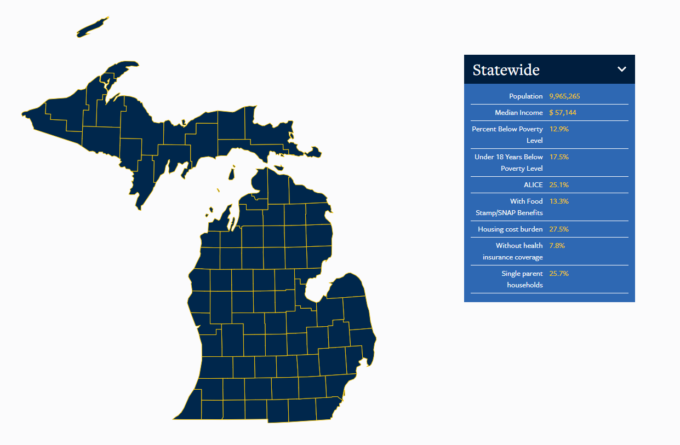Michigan poverty map identifies regional needs related to child care, health care, affordable housing

Contact: Lauren Slagter, lslag@umich.edu, 734-929-8027
A new data map displaying a variety of poverty and well-being metrics across Michigan holds implications for how federal American Rescue Plan Act funds could be used to address the state’s most pressing needs.
Poverty Solutions at the University of Michigan has released an updated version of its Michigan Poverty & Well-being Map with county and regional data. The new iteration of the map, which Poverty Solutions has maintained since 2017, features 2019 data from the Census Bureau’s American Community Survey, the most recent available.
“The poverty rate alone doesn’t tell a complete story of how many people are facing economic instability and hardship. The Michigan Poverty & Well-being Map looks at multiple metrics to give us a more holistic sense of Michiganders’ well-being,” said Poverty Solutions faculty director Luke Shaefer, the Hermann and Amalie Kohn Professor of Social Justice and Social Policy, and a professor of public policy and social work.
Overall, Michigan residents were in a more stable financial position than in previous years, according to key metrics:
- 12.9% of the population were living on income below the federal poverty line
- 17.5% of children under the age of 18 were in households below the federal poverty line
- 7.8% of working-age adults did not have health insurance coverage, a new metric added to the map this year
“The map gives us a pre-pandemic snapshot of well-being across Michigan and how many people were struggling to afford basic necessities,” said Amanda Nothaft, senior data and evaluation manager at Poverty Solutions, who led the data analysis for the map project. “We know the COVID-19 pandemic brought increased financial hardship for many families and also unprecedented levels of government support to help people through that difficult time.”
Looking ahead, Nothaft said the disparities brought to light by the Poverty & Well-being Map can inform how state and local officials prioritize the use of federal American Rescue Plan Act funds. The updated map divides the state into 10 regions—which match the prosperity regions defined by the state of Michigan—to offer a nuanced look at the unique dynamics at play in different parts of the state.
A series of regional factsheets highlight the need for increased access to child care and health care, investments in transportation infrastructure, and more comprehensive affordable housing solutions in certain communities.
“The influx of federal funds from the American Rescue Plan Act provides a rare opportunity to address some of the underlying disparities and drivers of poverty in Michigan,” Nothaft said. “The Poverty & Well-being Map can help local leaders make informed decisions about their communities’ most pressing needs.”
See the regional factsheets:
- Detroit Metro: Burdened by Cost of Housing
- East: Fighting Food Insecurity
- East Central: Declining Population Amid Diminishing Economic Opportunity
- Northeast: Barriers to Health Care Access
- Northwest: Quality Child Care as an Economic Mobility Issue
- South Central: Investing in the Future Workforce
- Southeast: Wide Disparities in Median Income and Access to Health Care
- Southwest: Addressing Water Infrastructure and Affordability Needs
- Upper Peninsula: Aging Population and Health Care Challenges
- West: Burdened by Transportation Costs
